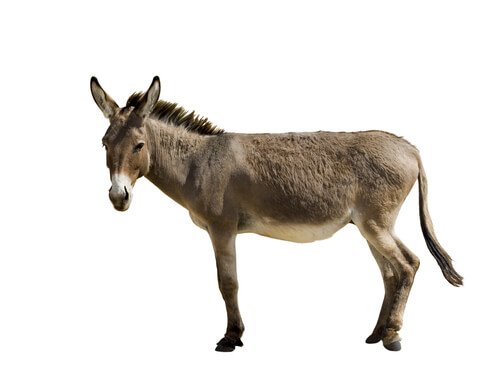The Origins of the Mule: Here's the Story
The mule is a terrestrial quadruped mammal belonging to the Equidae family and the order Perissodactyla. The name comes from Latin and people used it for a lot of different species. But where exactly did the mule come from?
This hybrid is a cross between female horses and male donkeys. Due to mules being generally sterile, their survival is completely dependent on horses and donkeys mating with each other. The few mules that are fertile usually give birth to weak, fragile babies that die at a very young age.
They’re compact, robust animals, and they look more like donkeys than horses. They sort of have a round, wide body, with a long, spiny neck. Their heads are shorter and wider than a horse’s, and they have long ears. They also have thin legs, small feet, and thick hooves.
It can be easy to confuse mules with donkeys, but the difference is obvious if you look closely at their colors. Donkeys have thin tails with a small tuft at the end, similar to a cow. Mules have a tail high up on their body with hair more like a horse’s.
The differences between male and female mules
Male mules are slightly bigger than females. They have thicker, rounder legs, and a longer body, with their hind quarters much closer to the tail than females. Males also tend to be stronger and tougher than females, and have a longer life expectancy.

The origins of the mule: history can help us understand their “bad reputation”
It’s hard to put an exact date or place of the mules’ origin. Some people think their existence has more to do with human involvement than with the natural interaction between horses and donkeys. Female horses have probably reproduced naturally with donkeys before, but it’s unlikely that would be enough to create a new species.
Most likely, mules come from the fields of the United States, the country where they first became popular. Their contributions to agriculture were so major that even George Washington wanted to breed more. However, his plans were momentarily stopped by Charles III of Spain, a passionate defender of the Andalusian donkey.
To prove his theory, Washington sent two males and females to this Spanish king as a gift. One of the males died on the way, but the surviving “gift” changed King Charles’ perception of the species.
The mule population in 20th century United States increased to over 6 million. That number only started to go down during the industrial revolution. The decrease was so sharp that by the 1960s, there were only 10,000 mules left.
Animal abuse
Sadly, the history of the mule isn’t just one of happiness and success. People exploited them in countless inhumane ways. They practically always lived in unhealthy conditions and didn’t receive proper care from their owners.

Unfortunately, mules never gained the fame or good reputation of their relatives, horses. They didn’t have the same beauty and never won any important sports or beauty pageants. People always saw them as work animals that were only meant for hard labor.
Mules rarely got proper treatment at the farms and fields they worked on. Their owners often left them outside day and night, and they usually died from the intense, endless workloads.
Their treatment in the US was so violent that activists started to take action in their defense. A lot of mules also died in the 60s, after being abandoned once tractors took over their jobs. That was when some people banded the creation the American Society of the Donkey and Mule that was dedicated to protect them from exploitation and abuse.
The Idaho Project and mule reproduction
In the 2000s, the US announced the beginning of the “Idaho Project.” Its objective was to promote more studies about mule reproduction and try to clone them for the first time.
The first cloned baby mule was born in May 2003, after a controlled pregnancy for almost 340 days. His name is “Idaho Gem.”
